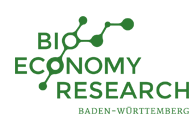Competence Network Modeling the Bioeconomy

The analysis of the potentials, risks and opportunities of the bioeconomy cannot be confined to individual usage pathways, but must consider the complete system of supply and demand, including different sources (e.g. forestry, agriculture, landscaping, waste, aquaculture, algae) and uses (nutrition, fodder, energy, material) of biomass.
The necessity of an integrated analysis of the bioeconomy is the result of a diverse resource competition, that is mainly caused by the scarce production factor land. Resource competitions have an effect on international, national and regional levels. As a result, indirect changes in the supply and use of biomass via regional and global market integration can cause alterations in completely different sections.
In addition to these conditions, the analysis of the bioeconomy must confront the challenge of rapid economic and technological development in the supply and use of biomass. Further complicating matters is the fact, that many technologies are not yet ready for market. Nevertheless, it is necessary to already begin estimating the potentials, opportunities and risks of the bioeconomy of the future.
In this context the Competence Network Modeling was funded by the Bioeconomy Research Program Baden-Württemberg. The overall objective of the Competence Network Modeling was to closely work together with all three research areas in order to develop methods that permit comparative evaluations of biomass use within the different types of usage. For this purpose, simulation modeling is a widely used methodological approach for the ex-ante analysis of market and technological developments and their impacts. The Competence Network Modeling has used general and partial
- equilibrium models
- energy system and material flow models
- life cycle assessment
- agricultural operations models and
- localization optimization approaches for biomass conversion plans
for analysis of possible development paths for the bioeconomy network. For this purpose, interfaces between the models were developed to connect the different model approaches with “soft links” and calculate integrative modeling scenarios.
